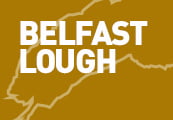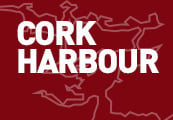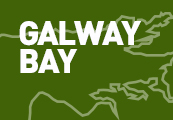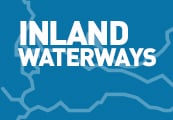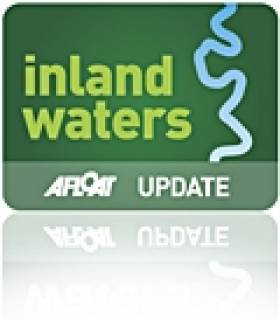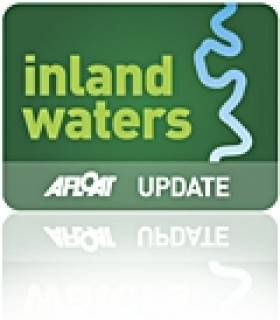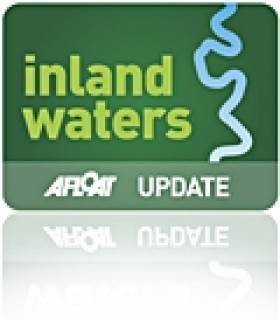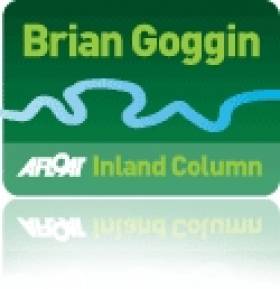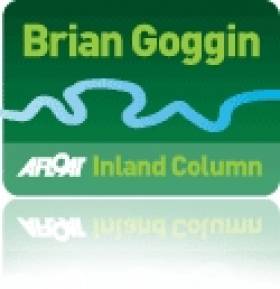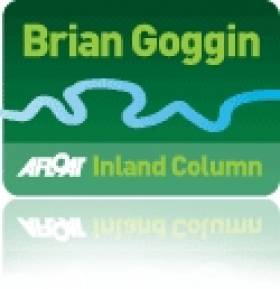Displaying items by tag: inland waterways
Marathon Style Canoe and Kayak Event - Inland Warning
Competitors will race from the Round "O" in Enniskillen, to a point 5km upstream and return to the "Finish Line" at the Round "O".
Masters are requested to note any advice or instructions given by the event organisers and marshals and to give competitors a wide berth at all times.
Vessels should proceed at slow speed and with minimum wash when passing canoes and kayaks.
Dublin Dragon Regatta - Grand Canal Disturbances
Racing will be on the North Side of the outer dock. Masters and owners of vessels operating in Grand Canal Dock should refrain from entering the race course and comply with guidance instructions from race officials.
Waterways Ireland apologises for any inconvenience caused by this restriction and thanks its customers for their cooperation.
Lough Key Triathlon Shannon Warning
Masters of vessels are requested to note the advice of marshals when passing near the course and to proceed at slow speed with minimum wash.
Minister Deenihan Opens new waterway development in Killaloe
The Minister for Arts, Heritage and Gaeltacht Mr. Jimmy Deenihan, T.D., today opened the new moorings and walkway on the Shannon Navigation in Killaloe. Developed by Waterways Ireland and jointly funded by Fáilte Ireland the €2m project involved the installation of 775 metres of moorings, the underpinning of the old canal wall, the installation of the flood control gates and the completion of a looped walk along the shore and canal wall.
Commenting at the redevelopment, Minister Deenihan said "The improvement works undertaken here at Killaloe Canal have been extensive and will prove important in increasing visitor numbers to this very scenic area of Co. Clare. The project, funded jointly by Fáilte Ireland and Waterways Ireland, will make an excellent facility for walkers, tourists and those who enjoy waterway activities. I have no doubt that this development will only add to this region's reputation as one of Ireland's most attractive and enjoyable destinations for visitors from both at home and abroad."
This project has been funded by Waterways Ireland and Fáilte Ireland under the Lakelands and Inland Waterways Strategic Initiative. This Initiative is a partnership jointly chaired by Fáilte Ireland and Waterways Ireland, with Shannon Development, Fermanagh Lakeland Tourism, the Northern Ireland Tourist Board and Tourism Ireland as partners.
A key element of the Initiative is product development and Waterways Ireland along with its partners Shannon Development, Fáilte Ireland and the Local Authorities have formulated Product Development Studies for the Lakelands and Inland Waterways area including Lough Derg. These studies chart the future development of tourism, recreation and navigation in the Lakelands and Inland Waterways area over the short and medium term. The development at Killaloe is but one example of the development of top class facilities for boaters, tourists and the local community identified in the Studies.
John Martin, Chief Executive of Waterways Ireland stated "Killaloe/Ballina is a key destination and gateway in the Lakelands and Inland Waterways area for domestic and international visitors. The development here in Killaloe is part of our strategy in Waterways Ireland and is key in encouraging further economic activity in the town and indeed the wider Lough Derg and the Lakelands and Inland Waterways area".
Fiona Monaghan, Fáilte Ireland, explained the importance of developing tourism offerings in the area "While value for money and a high quality customer experience is an important part of selling Ireland as a destination both at home and abroad, ensuring our regions are fully equipped to cater for visitors is equally a crucial aspect to developing tourism in Ireland. Rivers and marinas form an important part of our tourism offering and this investment in the development of the Killaloe Canal signifies Fáilte Ireland's commitment, as the national tourism development authority, to ensuring that there are plenty of reasons for visitors to come, and indeed return to Co. Clare and the Lakelands & Inland Waterways region this year, and into the future".
Now in its fourth year, the Lakelands and Inland Waterways strategic initiative has also invested over €3m in the international and domestic marketing of the tourism and waterway corridor from Belleek to Limerick. The strategy has engaged communities and businesses from attractions, hotels, restaurants, boat hire, and activity providers in building an authentic Lakelands and Inland Waterways brand for this region, a brand which will draw visitors to the unique experiences the region provides.
National Canoe Polo Championships - Royal Canal
Waterways Ireland wishes to advise all masters and users of the Royal Canal that the above National Championships will take place in Richmond Harbour on Sat 23rd. and Sun 24th. July.
The following timetable will apply:
| Date | Time | Event |
|---|---|---|
| Fri 22 Jul | 14.00hrs onwards | Course set up |
| Sat 23 Jul | 09.00hrs to 13.00hrs | Competitions |
| 13.00hrs to 14.00hrs | "Harbour open to through traffic | |
| 14.0hrs to 19.00hrs | Competitions | |
| Sun 24 Jul | 09.00hrs to 13.00hrs | Competitions |
| 13.00hrs to 14.00hrs | "Harbour open to through traffic | |
| 14.0hrs to 17.00hrs | Competitions |
All vessels will be required to be clear of the harbour by 14.00hrs on Fri 22 July to facilitate the setting up of the course but may return after 17.00 hrs on Sun on completion of the event.Further information may be had from Mr Ciaran Clinton , North Kildare Canoe Club on 00-353-87-8482191.
Largest Vessel Transits Samuel Beckett Swing-Bridge
She remained alongside this berth which is normally used by large commercial ships until the vessel sought a berth much closer to the city-centre. This led to a shift of berths in the evening when the 2003 built vessel headed upriver to the Dublin City Moorings facility at Custom House Quay, but this firstly required transiting through two bridges.
With a beam of 10.6m Fortunate Sun entered through the East-Link toll-lift bridge followed by the Samuel Beckett bridge, the Liffey's newest crossing point which opened in late 2009. The €60m bridge was commissioned by Dublin City Council and designed by the Spanish architect engineer Santiago Calatrava. To read more on the bridge click HERE.
Fortunate Sun is registered in the Caymen Islands and is capable of over 17 knots on a range of 5000 nautical miles. She has a steel hull and an aluminium superstructure and interiors also by Tim Heywood Design. In the early hours of tomorrow morning the vessel built by Oceanfast is to depart through the 5,700 tonnes bridge which was delivered by barge after a five-day voyage from Rotterdam.
There has been previous transits of the bridge notably the annual Dublin Rally organised by the the Inland Waterways Association of Ireland (IWAI). This year's Dublin Rally took place on 1 May when boats travelling on the Royal Canal descended via Croke Park and entered the Liffey at Spencer Dock. This required the Iarnrod Éireann bridge-lift and the water level in Spencer Dock to be lowered so to allow safe clearance under the Sheriff St. bridge.
From there the IWAI flotilla made the short passage downriver to re-enter another inland waterway system at the Grand Canal Dock, marking where the Liffey connects with the city's southern canal. The 2011 Dublin Rally was the first time since 1955 that boats could enter Dublin from the Shannon via the Royal Canal and the first time since 2004 that boats also joined from the Royal Canal.
- powerboats
- motorboats
- inland waterways
- Dublin Port
- Dublin
- Grand Canal
- IWAI
- Royal Canal
- DDDA
- Inland Waterways Association of Ireland
- Dublin City Council
- Spencer Dock
- River Liffey
- Ports and Shipping News
- EastLink Toll Bridge
- Dublin Port news
- Grand Canal Dock
- Dublin Docklands Development Authority
- M.Y. Fortunate Sun
- Tim Heywood Design
- Lifffey
- Dublin City Moorings
- Custom House Dock
- Powerboat news
- Motoryachts
- Sir John Rogerson Quay
- Inland Waterways news
- Dublin Rally
- Ianrod Eireann
- Oceanfast
- Scottish Western Isles
Trust In The Future?
As the cuts begin to bite, it may be time to look at the British direction for our waterways, writes Brian J Goggin
Foreign weatherThe other night, I went to the inaugural meeting of a new lobby group called the Campaign for Real Irish Weather (CRIW). The group's aims are to secure a restoration of traditional Irish weather patterns, and it intends to lobby both local authorities (like the Irish Government) and central government (the European Commission, the ECB and the IMF).
As the new organisation's president, Francis Beaufort, put it forcefully: "For the last few years, foreign weather has been dumped in Ireland. Sunshine in May is all very well, but it's not very useful at that time of the year. And the price we pay is ice and snow in winter, which we definitely don't want. What we need is nice gentle rain all year round, giving just the right amount of water in the rivers, with neither drought nor flood."
I could see what he meant. In October we went up the Shannon and along the Shannon Erne Waterway (SEW) to Ballinamore: it was very cold and our newly-installed heating was essential. But there was even colder weather ahead: throughout the winter, owners had to worry about the effects of ice; several boats sank and no doubt there will be others with damaged engines. Bring back rain.
Rain returnsThere was plenty of rain on the first weekend of February, when IWAI Lough Derg Branch members and people from the O'Briensbridge Community Group turned out to remove timber from the upper end of the Plassey–Errina Canal.
This was the old route between Limerick and Lough Derg. When Ardnacrusha was built in the 1920s, the headrace weir at Parteen Villa blocked the river, preventing boats from reaching O'Briensbridge and Castleconnell. The old weir at World's End, Castleconnell, still keeps up the level, so there is plenty of depth, but nowadays (with one exception) only small boats — mostly angling boats and rowing skiffs — use this stretch of river.
However, the Community Group has developed looped walks along the towing-path. The British Inland Waterways Protection Society visited in October, walking from the Limerick canal harbour to O'Briensbridge, and described the canal as a "national treasure". It has a wealth of artefacts, including seven milestones along the 12-mile route.
The group and the IWAI are now clearing the top section of the canal, so that small boats can travel from the river as far as the first lock at Errina. A small but select group turned out, with two boats, and has now reopened the navigation as far as the farm-house at Drummeen. Another couple of weekends are planned to complete the work, although silt inflow below a drain may pose a problem.
Tightening the beltsOther IWAI branches are active too: Dublin working on the Grand Canal graving docks, Newry & Portadown on the Newry Canal. And so are other groups: Drimnagh Friends of the Grand Canal in their area of Dublin, Breffnie O'Kelly and others further east in the city.
The question now is whether Waterways Ireland should start thinking about some more formal arrangement with groups of volunteers, to build them into its plans and its structures.
The Sunday Tribune of 9 January 2011 said that Waterways Ireland's staff increased from 355 last year to 367 this year. It said that the Department of Community, Equality and Gaeltacht Affairs (to which Waterways Ireland reports in the southern state), or rather its minister, was "among the worst offenders when it comes to increasing staff numbers in the agencies under his remit".
Waterways Ireland did well from Fianna Fáil's budgets: it has many new vessels in its fleet, new offices and new and improved systems and procedures. But the days of high spending may be over. The budget, in December, showed that the Department's current expenditure allocation to Waterways Ireland in 2011 would be down from e25,585,000 to e24,335,000 (a cut of just under 5%) while capital expenditure would be down from e8,000,000 to e6,000,000 (25%).Admittedly, Waterways Ireland is now starting from a high base, but remember that we are facing several years of further cuts to get government expenditure back somewhere close to revenue. As it is, the Department of Community, Equality and Gaeltacht Affairs has been trying to get Waterways Ireland to pay for the Ulster Canal by selling surplus property, but it has missed the boat (or rather the boom).
British move to trustChanges are under way in Britain. British Waterways pulled out of the Cotswold Canals Partnership in 2008, a decision that seemed to signal the end of the era of big restoration projects.
Furthermore, BW needs more money than it has been getting. As WATERWAYS WORLD puts it, "Its commercial activities are flat-lining at best, the growth in boat numbers has slowed, and the Government grant is heading downhill fast."
Her Majesty's Government doesn't want to be bothered with all this when it's carrying out a cull of quangos, so it intends to transform BW into a charitable trust by 2012. Charitable status would allow BW to raise money from other sources (e.g. funding trusts, individual donations, legacies). It would have some tax advantages and it would also allow BW to borrow.
One major component of the plans is that BW would use the services of volunteers more. Some would work as individuals but in other cases voluntary bodies would work with BW. There is a sort of pilot scheme on the Kennet & Avon, where BW and the Canal Trust have formed a Waterway Partnership.
Needs must?Now, I don't expect the Department of Community, Equality and Gaeltacht Affairs to greet with glad cries this — or any other — suggestion for change. Waterways Ireland was set up with no board, no formal involvement of any outside persons or bodies, just a chief executive reporting directly to the two government departments, north and south, and their ministers. It's hardly likely, therefore, that proposals for popular involvement will be welcomed.
But if the British solution works, and if financial cuts continue north and south, the powers that be may have to consider a new business model.
Published in Afloat March//April 2011
Inland Waterways Column: Going off-piste On Water
With the boat laid up for winter, there's a chance to think about some of the smaller and less-well-known navigations on our inland waterways.
In winter, when the vegetation has died back, it's easier to see hidden features, and (if it's not raining) the light is often very good for taking photographs.Several of these navigations could be tourist attractions. The Irish tourism product needs to be revitalised — and that includes the waterways product. Shannon traffic figures this year are down about 25% on 2006 and registrations of new boats are down about 50%. One market that hasn't really been tapped is that for industrial heritage, and the waterways have lots of it, but even abandoned waterways also offer activities (walking, kayaking) and opportunities to get away from it all.
In some cases, though, the powers-that-be don't realise what they have and what they could (at low cost) do with it, while in others the powers seem determined to block public access to the waterways. Here are some of the problems and the opportunities.
The Maigue through Adare
The Maigue flows north through Adare into the Shannon Estuary. In bygone days it was regarded as a separate navigation and the annual Board of Works reports covered it separately.
There was a plan to link Limerick to Cork by canal, but it got no further than making the Maigue navigable to Adare. A short canal ran from the river into the centre of the town. When the railway came, it cut off the entrance to that canal; the old harbour is now beneath an iron works and a new quay was built downstream of the railway bridge. You can walk down the bank from there; you can also visit the Maigue at Ferrybridge on the N69.
Although commercial traffic was confined mostly to turf boats, and not many of them, the navigation continued in use until the 1920s. However, I have found no evidence — in Oireachtas records, in legislation or in statutory instruments — that the navigation was ever formally closed or that the Office of Public Works ever passed over its responsibilities to any other organisation. I have been pestering an unfortunate official of the OPW for some time now; he has found no relevant records.
Accordingly, I believe that the OPW is still the navigation authority for the Maigue, and it might perhaps give some attention to dredging and to the installation of aids to navigation.
In Clonmel itself, flood prevention works have resulted in the construction of walls all along the river, with no provision (as far as I could see) for access to the river. I saw one group of people launching boats on planks laid down a flight of steps; couldn't a slipway have been provided somewhere? And what about providing somewhere safe for boats to be tied up, with a gated pontoon so that people wouldn't have to clamber over walls to get to their boats? Sixty foot wooden yawls (shallow lighters) used to carry goods to Clonmel, but the town seems determined to turn its back on the river and to make it hard for people to use it for pleasure.The Limerick Navigation
The Limerick Navigation, the old route between Limerick and Killaloe, was abandoned in 1929 when the new route through Ardnacrusha was opened. However, the towing-paths remain in public hands, although Limerick City and County Councils leased parts of them from the Office of Public Works.
In the early nineteenth century, the Limerick Navigation was the scene of operations of the most remarkable inland waterways fleet ever seen in Britain or Ireland. And the navigation itself is packed with unusual features, some of which are unique but most of which are still accessible. It is possible to walk the old towing-path from Limerick to the university grounds at Plassey, then across the river and along the canal to Gillogue. There is a break in the accessible stretch there, but you can walk by road, or along the headrace, to Clonlara, and regain the towing-path there. The route continues along the canal to the Shannon, then by the river through O'Briensbridge to Parteen Villa Weir. The Flooded Area covers the navigation from there to Killaloe, but the old canal at that point has a great wealth of artefacts.
But nowhere is there anything to tell you that you are walking the Limerick Navigation or that these stretches of towing-path were all part of one route. There is nothing to identify and explain the various features or to discuss the boats, the people and the cargoes that went along this route. It would cost very little to make the Limerick Navigation into a tourist attraction: interpretation and marketing are the main needs.And now the route itself is threatened. The Black Bridge, built by Thomas Rhodes in the 1840s to allow towing horses to cross the river, bears on its parapets the grooves worn by the tow-ropes. It was damaged by last winter's floods and has been closed off. It is possible to cross the river using the university's road bridge, but the Black Bridge itself should be saved, repaired and re-opened as a part of this tourist route.
Plenty to pick from in Estuary
If you want a quick lesson in transport history, get in your car and spend a weekend driving around the Shannon Estuary (a ferry links the Kerry and Clare sides). Some of the attractions (those that charge fees) close for the winter, but there is still lots to be seen.
If you like traditional boats, look for the gandalows from Limerick down (and on the Cashen in north Kerry) and the canoes (currachs) in west Clare. Note the large number of stone piers, built for the estuary steamers and now largely abandoned.
The main steamer ports were Cappa (outside Kilrush) and Tarbert; you can see how the piers were built and extended — and you can think about the early iron steamer Garryowen: when it survived being cast ashore in a gale, the news went around the world and convinced many shipowners to adopt iron for their fleets.
In the summer, you can add the West Clare Railway at Moyasta (between Kilrush and Kilkee), the reproduction monorail Lartigue Railway at Listowel, various stations on the Limerick and North Kerry lines and the flying-boat museum at Foynes.
The individual attractions in this area are fine by themselves, but put them together as an industrial heritage (transport) package and you have something that will bring enthusiasts from overseas — and as the attractions are already there, the cost would be minimal.Hidden treasures
You never know where you're going to come across a trace of an old canal. The most surprising I've found so far was in Johnstown, Co Kilkenny. It is marked on the 1840 Ordnance Survey map as "Old canal" and the bridge shown in the photo is on a road called "Canal Road": that's what we call a clue. The canal seems to have served a single estate, probably allowing farm materials to be moved around and perhaps brought to and from the road.
There was also a canal system in the bogs on the Dublin side of Roscrea, near Racket Hall. Turf was carried by boat, hauled by donkey, to Birch Grove distillery, where the Equality Authority now has offices. A visit to the area should also take in the small but remarkably atmospheric ruins of Monaincha Abbey.
Several waterways books mention the Rockville Navigation, a series of small lakes linked by cuts near Hillstreet in Co Roscommon. One of the cuts is spanned by a fine, but recently damaged, bridge which bears the date 1765, but I have found no written information about who built the navigation or what it was used for. It is still navigable by small boats, though: I went down it myself last summer, from the bridge to the Silver Eel at Grange, and a group from the Heritage Boat Association carried out a more extensive survey.
The Mayor of Roscommon, Cllr Luke Ming Flanagan, kayaked down from the bridge with a companion; with a slight flow on, they reached Grange in a couple of hours. A small investment — perhaps a launching ramp, a bit of tree-trimming and some signposting — could create a new visitor attraction for the county, appealing to those who want a not-too-strenuous kayak or boat trip.
The era of big waterways projects is probably over. For the future, we need to think small.
Published in Afloat December 2010
Shannon Hits Half Century
The 50th rally on our great river was a runaway success, writes Beth O'Loughlin
In July, when Waterways Ireland (WI) published its vision and strategy for the resurgence of the canals and rivers in Dublin, 140 boats crewed by over 500 people gathered in the middle of the country to celebrate our great 'Silver River'. The 50th Shannon Rally was enjoyable, well organised and a huge success.Rallies on inland waters in Ireland evolved in the latter part of the 1950s when a few small events were organised by the fledgling Inland Waterways Association of Ireland (IWAI). But it was not until 1961 that the Athlone and Carrick-on-Shannon branches got together for the first Shannon Rally. This type of event has always formed part of the overall campaigning aspect of the IWAI, to oppose any obstruction to the navigations and to champion the safe use of and improvements to our canals, lakes and rivers.
Looking at the pictures from 1961, one can't help noticing the difference in craft between then and now; on the original Shannon Rally, the 70 or so boats taking part consisted of open boats, sailing dinghies, wooden cruisers and a handful of barges. This year, there were just a few open boats, over 110 cruisers of all sizes and designs, 20 barges and a sailing boat. It attracts people of all ages with many who attended in the 1960s and 1970s now attending with not only their children but also their grandchildren. It was delightful to see at least two of the boats from 1961 (there may have been more) on the 2010 Rally; 42B Snark built in 1913 and 49M Ye Iron Lung built in 1928. Every Branch of the IWAI was represented, along with the Heritage Boat Association (HBA).
The event was opened in Carrick-on- Shannon by President Mary McAleese, who spoke of her family's experience of boating on the Shannon, the significance of the Shannon to the towns, villages and communities along its route, how you see Ireland from a different perspective when on the river and commented that "boating people don't care about the weather", as rain threatened. She praised IWAI volunteers as the custodians and champions of our 'silver river', who cherish it, teach us to be careful of it and safeguard it for future generations.
During his address, Donal O'Siochain, the Commodore of the 50th Rally, pointed out that more and more people are choosing to holiday in Ireland on our rivers.
This marked the beginning of a wonderful week of fun, training and competition. There were events for every age and predilection; the organisation was excellent, and every participant was made to feel welcome.
Tight fit for all
One of the many challenges facing the organisers was how to moor 140 boats and barges in harbours built for 60 or so boats. They did it by extending quay walls and jetties with barges and mooring boats four to five out. Boats and barges were moored next to those of the same deck height wherever possible, allowing safe passage across decks. Those with special needs got priority and were moored next to the quays and jetties. The process was carried out without fuss; an outstanding achievement by the harbour masters.
The fleet cruised from one end of Lough Ree to the other, meeting up at Ballyleague near Lanesborough on the first weekend, then cruising to Portrunny, the Lough Ree Yacht Club, the Inner Lakes and ending up in Athlone. Sunday morning we had the first Skippers Briefing and all boats picked up their rally pack and the coveted plaque. Afterwards, the local Sea Scouts, who had fed many of us the night before with a BBQ in the park surrounding the Ballyleague moorings, were welcomed on board for the cruise to Portrunny. Once safely moored up, there was an ecumenical service followed by a cheese and wine party which segued into a very enjoyable music session in the marquee and ended in the wee hours.
With no need to move or moor boats, Monday was a great social day; there was 'Open Barge' for a couple of hours for those wanting to see the different types of barges attending and their interiors. There was a kid's treasure hunt; competitions for those participating had started the day before and continued; all sorts of water sports were available including 'learning to sail a dinghy'.
On Tuesday, we cruised to Lough Ree Yacht Club and tried very hard to stay in a convoy for a photo shoot from the air. An enjoyable BBQ and evening was spent at the Yacht Club. Wednesday was another 'rest' day; so as well as the boating competitions we had Commandos, Fancy Dress and Talent competitions, followed by some music.
On Thursday, after the Skippers Briefing we set off for the Inner Lakes, just a short hop around the corner. However, on the way 20 barges formed a raft on Lough Ree, with cruisers in a circle on the outside. At an agreed time for a photo shoot from the air, the raft moved clockwise while the cruisers circled anti-clockwise. Later there was a trip to Glasson Golf Club for the golfers; competitions and water sports continued and in the evening the now famous RNLI Rally Auction was held. Medals were presented on Friday and after various radio recordings, all settled down for a Sixties Rock night in the Shed, once again finishing in the wee hours. We left next day for Athlone and moored up north of the bridge and on the jetties. Prize giving took place on the Green. On Sunday evening the event ended with a dinner dance, presentation of the Premier and other awards, followed by music and chat ... into the wee hours, of course!
Knitting for lifeboatsThe Shannon Rally over the years has raised vast sums for the RNLI and this year was no exception with around e10,000 raised at last count. The monies were raised mainly by people contributing boating items for the auction and by contributions to the great 'Knitathon'.
The Knitathon, an inspired idea was where those with suitable talent, knit a six inch by six inch square ingeniously decorated with something that represented their boat. If you were not talented in this way, you could make a contribution to the RNLI for a square to be knitted by someone else and either decorate it yourself or cajole someone else into decorating it for you. All the squares were then sewn together into a blanket. All of the boats contributed, the squares were then sewn together to form a colourful blanket. A raffle in aid of the RNLI had the blanket as the prize.
One of the outstanding memories from this Rally will be a bunch of people sitting on boats sipping, chatting and knitting! Not something observed often in the boating scene.
Stories of a river"Stories of a River" is a compendium of short stories, reflections, photographs and memories from 30 contributors. There are articles, photos and ditties recalling times spent on the river and on rallies over the past 50 years; a great read for all who love the Shannon. It captures the magic of past rallies, the personalities involved and there are some lovely photographs.
The book was launched in July by Amanda Brunker, author and columnist. Amanda and her family participated in many rallies and have many happy memories as a result. "We loved boating as a family and had great fun on the river," she said. "It was an exciting time for all the families, especially the kids and the teenagers, spending a very active ten days outdoors on the river in Irish weather. I have memories of happy days of camping out, fishing, swimming and meeting and making many lifelong friends on the Shannon Rally."
The book "Stories of a River" is published by the IWAI Shannon Boat Rally with the assistance of Waterways Ireland. Available from http://shop.iwai.ie/catalog/index.php
Inland Waterways Column: Derg To Ourselves
Always a late starter, Brian J Goggin was surprised to find a deserted Lough Derg on a sunny weekend outing
We've never thought of ourselves as early birds: as our boat has no heating, our boating season starts rather late. But we were surprised, on two successive weekends, to find that others seem to be leaving things even later. Apart from sailing boats involved in a race, and anglers dapping, there were very few private or hired inland boats on the move on Lough Derg. At times, on a sunny weekend, there was no other boat to be seen in the middle of the lake. And that may have been the summer.Killaloe did have a large group of Emerald Star boats on one weekend: we were told they had been hired by a wedding party who were enjoying themselves (happily, on the Ballina side of the river) until the early hours of the morning. On the Killaloe side, the new floating moorings have had the pontoons installed, but Waterways Ireland has only recently called for tenders for the remaining work. So the shortage of spaces will continue for another while, causing difficulties for those heading for the excellent Killaloe market.
The town has acquired another attraction recently: the 12-seater fast trip boat Spirit of Lough Derg (www.spiritofloughderg.com), operated by the same people as the existing 50-seater Spirit of Killaloe. The new boat is offering one-way charters between Killaloe and Limerick so, if you've never been through Ardnacrusha Lock (an experience not to be missed), here is your chance. See the website for details.
Take a boat to the theatreIf you've been near the Grand Canal in the more salubrious parts of Dublin recently, you may have seen the Heritage Boat Association barges, fleet auxiliaries and other supporting vessels. The fleet entered Dublin somewhat ahead of the annual Dublin Rally, and has been making the most of its time: visiting restaurants (including the MV Cill Airne) by boat, travelling up the Liffey to Islandbridge and taking a look downriver towards the sea. More photos and details on www.heritageboatassociation.ie.
The MV Cill Airne and the restaurant boat Riasc are both ventures of Irish Ship & Barge Fabrication (www.isbf.ie) whose latest vessel, the Cadhla, is now on the Grand Canal. This electric vessel offers a daily "customised canal tour", written by Pat Liddy, as well as pre-theatre cruises during the evening. You can take the Luas tram to Charlemont Place, transfer to the barge and eat while travelling slowly to the Grand Canal Theatre. Post-theatre drinks and a trip back to Charlemont are also available. See www.citycanalcruises.ie.
Rambler through the RoyalWhat do you do if your boat is in Dublin, you want to get it to the Shannon but it's too big for the Grand Canal and it's not designed for the sea? You wait for Waterways Ireland to reopen the Royal Canal, even if that takes a while, as its locks are longer than those of the Grand.
The Rambler was one of five steamers used by the Midland Great Western Railway Company, which owned the Royal Canal, from 1875 onwards. She was able to carry 30 tons and to tow unpowered boats. The Company ceased carrying in 1886 and the Royal reverted to horse-drawn traffic.
Since then, the Rambler has passed through many hands and been converted and reconverted many times. The most recent conversion was done in the Grand Canal Basin in Ringsend, to which she was carried by road; since then, the Rambler has remained in the Basin awaiting the reopening of the Royal Canal so that she can return to the Shannon.
That reopening is now in sight: Waterways Ireland expects it in September 2010, and it has set up a working committee to plan appropriate events and celebrations. The committee includes waterways bodies, local authorities, anglers and the Kilcock Canoe Polo Club, which uses the Kilcock canal harbour for its sport (www.kilcockcanoepoloclub.com).
As a preliminary event, the HBA fleet visited Spencer Dock, where the Royal Canal meets the Liffey. The Rambler, carrying a party of Royal Canal Amenity Group members, was in the van, with the former horse-boat 4E behind: although built for the Grand, she was used for maintenance on the Royal from the 1950s.
The last cargoThe last commercial cargo to be carried on the Grand Canal was stout to Limerick. Guinness needed time to build a new depot near the railway station, so the water-borne service to Limerick continued until 1960.
The last consignment was in May 1960, carried by the Grand Canal Company's motor-barge 51M. Unlike many of her sisters, 51M was not sold off afterwards. She remained in the CIE (and now in the Waterways Ireland) maintenance fleet, fitted out for repairing locks and known as the Carpenter's Boat. Like the Rambler, she has been in the Grand Canal Basin for many years.
The Heritage Boat Association has received permission from Waterways Ireland to recreate the last commercial voyage, and will be moving 51M westward along the canal. The crew will include descendants of the man who skippered her on her historic voyage.
Mud rules Limerick outIt would be nice if 51M could travel all the way to the old canal harbour in Limerick, but access may be difficult at the moment. A fleet of boats from Lough Derg had intended to visit the Limerick Riverfest at the start of May but changed their minds when it became apparent that much dredging was required after the winter floods.
That wasn't the only casualty: Limerick County Council has closed the Black Bridge at Plassey. This bridge was built in 1842, as part of the improvements made by the Shannon Commissioners, and replaced a ferry. It enabled towing horses to cross the river: the towing-path of the Limerick Navigation was on the Limerick side from the city up to Plassey, but in Clare, on the other side of the Shannon, the rest of the way to Killaloe.
Hauling a laden barge across the river, against the flow of the Shannon in flood, can't have been easy, and the parapet of the bridge bears, to this day, the grooves cut in it by the tow-ropes. The closure of the bridge has cut in two the popular walk from the city through Plassey and along the Plassey-Errina Canal to Gillogue.
The winter floods have damaged the bridge's supports. However, I have been unable to find out why Limerick County Council, rather than Waterways Ireland, thinks it is responsible for the bridge.
It's a Suir thing"Though not a seaport, the town [of Clonmel], from its situation at the head of the Suir navigation, is the medium through which the corn and provision export trade is carried on between the southern and eastern portions of this large county and England. There are generally about 120 lighters, from 20 to 50 tons burden, employed in the trade of this town."
That was in 1839. In the 1930s, Major Rowland Raven-Hart wrote in 'Canoeing in Ireland':
"From Clonmel (rail) to Carrick (rail) the navigation is quite amusing, and these thirteen miles should certainly be done: there is no danger whatever, and this part would be a valuable introduction to comparatively shallow-water canoeing for the absolute novice. The current here is always good, and there are several small rapids. On the whole run from Clonmel to the sea there is no portage, nor is it ever even necessary to float the boat down, unless perhaps in exceptionally low water. The scenery above Clonmel is fair, from there to Carrick excellent."
The navigation of this section of the Suir was never easy. The standard vessel was the yawl, 60 feet long but shallow-draughted and carrying perhaps 16 tons in summer. The traffic was horse drawn, with 12 or more horses used to get the boats upstream. The river is shallow and the currents can be fierce, especially at Sir Thomas's Bridge, below Clonmel, where the horses had to wade through the water.
It was here that the Avondale came to grief:
"O brave Sir Thomas Osborne, you little did suspect
Against your bridge the Avondale was fated to be wrecked;
The cruel pier in her poor side conveyed a dismal hole,
Scamandering her precious freight of thirteen ton of coal."
From 'The Wreck of the Avondale', published in the Clonmel Chronicle in 1903. Happily, Captain Britt, his son and his "tarrier dog" survived.
Downstream boats could travel with the current, the horses returning to Carrick by road. Commercial traffic ceased altogether in 1923, although it continued on the tidal stretches from Carrick down to Waterford. However, the river is used by fishermen, canoeists and others, while the towing path is used by walkers.
If the Southern Regional Fisheries Board gets its way, though, there will be no more boats. It proposes to build a crump weir at Ballinderry, and had located concrete units there in the belief that it did not require planning permission. The weir, which would include a fish pass, would enable it to count salmon. Happily, South Tipperary County Council has insisted that the Board seek planning permission.
The Suir between Clonmel and Carrick is never going to see much
traffc from cruisers or other large vessels, but it is a very attractive stretch of water that is used by cots, kayaks and other open boats of various kinds. There might even be scope for tourist trips downriver using large inflatables or rafts. I cannot see why the counting of fish should take precedence over the interests of other river users.
Published in Afloat June 2010

